GEORGE SOUTHAM

George Southam and Catherine Cameron
George W. Southam was born 29
October 1830 in the hamlet of Neithrop, Banbury Parish, Oxfordshire,
England to Justinian
Southam and Lucy
Hunt. George was named for his paternal grandfather.

Baptism record for George Southam in Banbury
George was the only child of his parents, as his mother died when he was only one year old. Justinian married again when George was three years old, to Esther Bourton in Cropredy. Half-brothers and sisters were born, starting in 1834: Eliza, Hannah (who died as a baby), Mary Ann, Joanna (who died as a baby), Josiah, Edwin, and William. The family moved from Cropredy to Adderbury in 1838, then to Brailes the next year. Justinian's grandson, George Henry Southam recalled: "My grandfather, Justinian Southam, was a son of George Southam of Great Barton, Oxfordshire, England. He was born 12 March 1809, at Great Bourton, Oxfordshire, England. He married Lucy Hunt, daughter of William and Hannah Hunt on the 15th of October, 1829 at Little Bourton. Lucy was born on Easter of 1810, at Neathrop near Banbary, Oxfordshire and died at Little Bourton in July 1833, at the age of 23, while my father, George was yet a very young baby. Justinian belonged to the Church of Jesus Christ of Latterday Saints in the year 1844. He was also ordained to the office of a Priest in the Church under the hands of his brethren in the Priesthood. My father, George Southam, was born the 29th of October, 1831 at Neathrop near Banbury, Oxfordshire, England, in one of the Bourtons. He was apprenticed as a weaver and had the reputation of being a good weaver and was in charge of three looms. He worked for nine shillings a week." (History of George Henry Southam, as dictated to his daughter Alice Southam Cook)
In the census of 1841, the ten
year-old George was found living in Bourton
with Ann Hunt, his maternal grandmother. The census for
Bourton shows Ann Hunt (age 55, born in this county), Henry
Hunt (age 15, plush weaver), and George Southam (age 10).
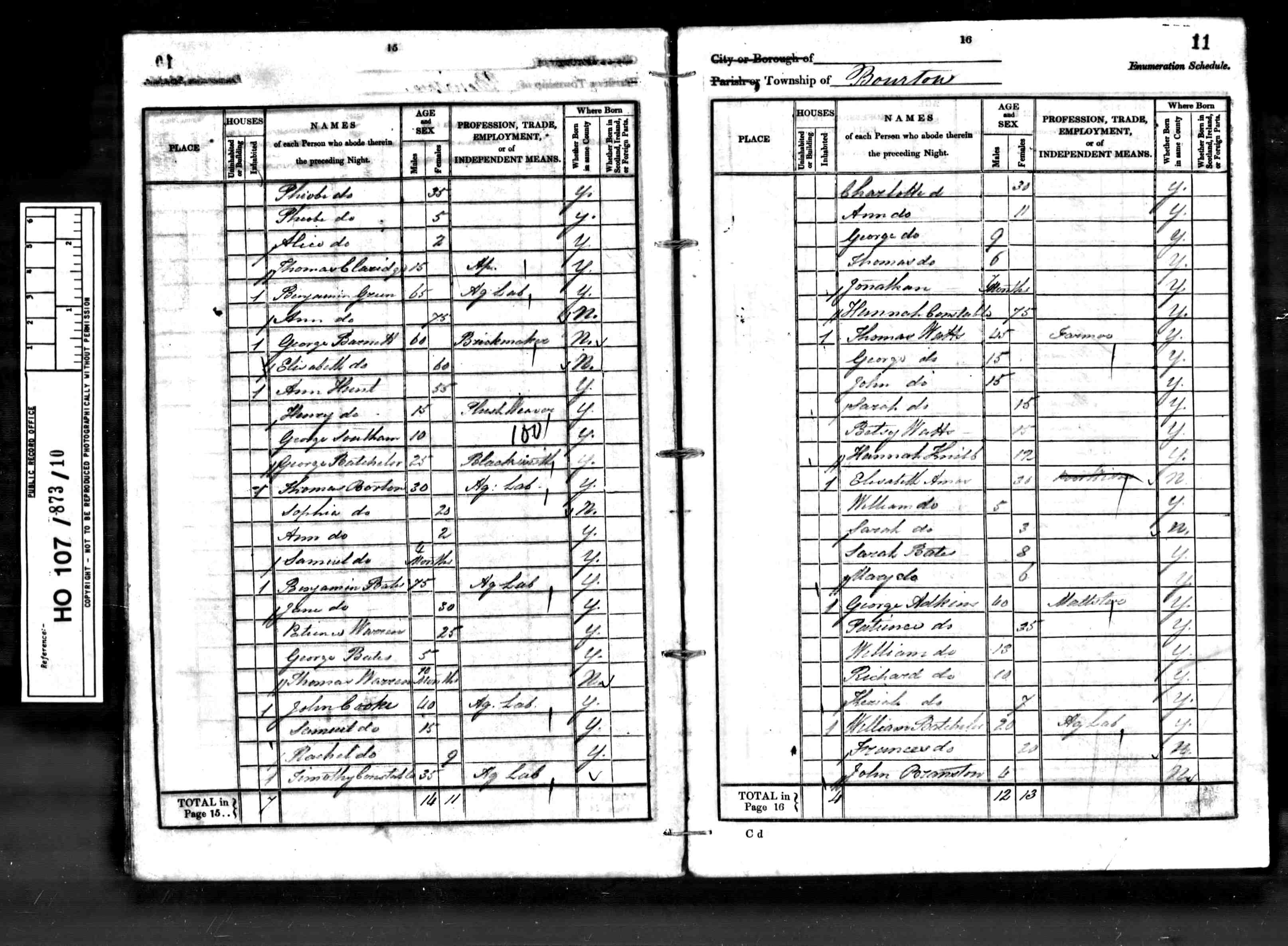
1841 census for Bourton, Oxfordshire
In 1844, Justinian and Esther Southam were converted to the Church of Jesus Christ of Latter-Day Saints: "Esther converted to the LDS Church and was baptized in 1844. George Southam was baptized in 1845 at age 14. Justinian died in England in 1848. Esther married again, in 1850, to a William Kilpack." (www.familysearch.org, posted by jwestra on 5 August 2021) According to his grandson, George Henry Southam, Justinian Southam was also baptized in 1844.
The 1851 census for Great and Little Bourton shows Henry Hunt (age 26, plush weaver), his wife Elizabeth (age 23), daughters Lucy (age 4), Ellen (age 2), son Hiram (age 3 months), and their lodger, George Southam (age 20, plush weaver).

The family lived at 30 Hobleys Lane, Neithrop, Oxfordshire.
The area is described, "The greater part of the western
side of Hobley's Lane comprised a terrace of 11 single
storey ironstone cottages with garretts set into high
pitched thatched roofs. The windows were protected by
shutters opening down wards." (Cake and Cockhorse,
Winter 1966) Henry Hunt is also mentioned in the
magazine article about an 1850 survey for the Anglican church
in Neithrop: “No 648 housed Henry Hunt, a Baptist plush
weaver, his wife, their three children, and a plush weaver
lodger.” [1] The neighbors were weavers, sawyers and
farm laborers. The town of Neithrop, near Banbury, had 45
plush weavers.
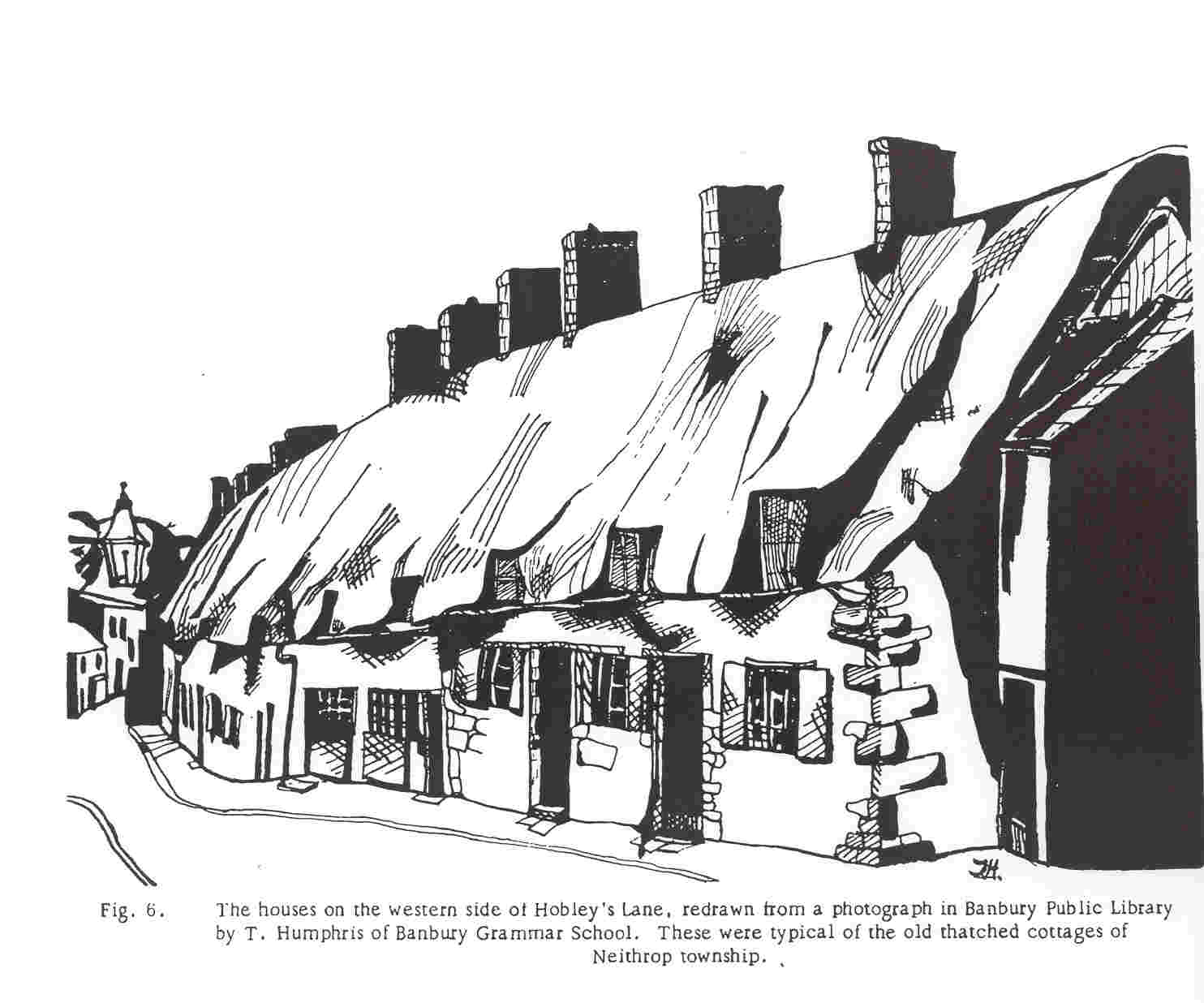 e
e
Homes on Hobley's Lane in Neithrop, where George lived
with
his uncle Henry Hunt's family in the early 1850s.
(Cake and Cockhorse, Winter 1966)
George was mentioned in the will of William Hunt, weaver, of
Great Bourton in 1853: "I declare that the said
Isaac Coy his executors and administrators shall by and out
of the monies which shall arrive from the sale calling in
and conversion into money of such part of my said personal
estate as shall not consist of money and of the money of
which I shall be possessed at my decease pay my funeral and
testamentary expenses and debts and pay and divide
the residue of the said trust monies unto and equally
between William Reynolds of Bugbrook in the County of
Northampton the said John Prentice, Michael Prentice of
Bledlow in the County of Buckingham, Elizabeth Prentice of
Bledlow aforesaid, Michael Grisold of Drayton in the said
County of Oxford, and George Southam the younger of
Little Bourton in the said Little Bourton in the County of
Oxford."

George worked as a plush weaver in Banbury,
and had charge of three looms. He heard the message of the
Latter-day Saint missionaries, and was baptized in September
of 1850 in the Coventry Branch, by Charles Anton and David
Walker. George's stepbrothers, Josiah and William were also
baptized, and emigrated to Utah.

George was married Jane Carter 29
November 1854 in Banbury, however, the ship’s passenger list
for the Clara Wheeler shows:
George Southam, age: 23,
origin: Branbury, occupation: plush weaver
Note: BMR, p.
179, Customer #68
George's address is shown as "care
of John Kilpack, Broad St, Banbury, Oxon".
Jane Carter, age: 17,
origin: Banbury
Note: BMR, p. 179, Customs #68

Clara Wheeler ship's passenger list
The ship Clara
Wheeler set sail the day after George and Jane's wedding, with
the newlywed couple onboard.
Their journey is described this
way: “The Clara Wheeler, with 421 Saints on board,
including infants, cleared for New Orleans on the 24th
ultimo. Elder Henry E. Phelps took the presidency of the
company, with Elders John Parson and James Crossly as his
counselors. We commend these brethren and their company to
the watchful care and protection of our Heavenly Father, and
trust that his blessings will constantly attend them in
their journey to the land and cities of Zion.” (Millennial
Star, Dec. 9, 1854).
“The Clara Wheeler put into
the Mersey on the 30th November,
having been driven back by stress of weather. We understand
that she received no material damage and the Saints on board
were generally well, with the exception of seasickness.
After receiving further supplies of water and provisions,
she again put to sea on the 7th
instant with a favorable wind.” (Millennial Star,
Dec. 23, 1854)
“Seventy-eighth Company – 422
souls. The ship Clara Wheeler, with four hundred and
twenty-two Saints on board cleared the port at Liverpool
November 24, 1854, bound for New Orleans. Elder Henry E.
Phelps was appointed president of the company, with Elders
John Parson and James Crossly as counselors. After a rough
experience in the Irish Channel, being unable to proceed
against the incessant head winds and rough weather, the
Clara Wheeler was obliged to return to port on the thirtieth
of November. During this extraordinary experience the Saints
suffered considerable with seasickness. After receiving
further supplies of water and provisions, the ship again put
to sea on the seventh of December with a favorable wind, and
on the tenth she cleared the Irish Channel after which she
had a very quick trip to New Orleans, where she arrived on
the eleventh of January, 1855. Soon after leaving Liverpool
the measles broke out in the company, resulting in the death
of twenty children and two grown persons. One child also
died after the arrival at New Orleans which made
twenty-three deaths in all. On the twelfth of January, James
McGaw, the church emigration agent at New Orleans,
contracted with the captain of the steamboat Ocena, to take
the passengers to St. Louis at the rate of three dollars and
a half for each adult, and half of that for children between
three and twelve years old; and twenty-four hours after
their arrival in New Orleans, the emigrants were on their
way up the river. Nearly one half of the company had not the
means wherewith to pay their passage to St. Louis; but the
more well-to-do Saints who had more money that they needed
themselves, were influenced to lend to those who had none,
and thus all who desired to continue the journey were
enabled to do so. At St. Louis where the company arrived in
safety, the emigrants were met by Apostle Erastus Snow and
others, who gave the new arrivals a hearty welcome, and
conducted them to comfortable quarters, which had been
secured for their accommodation. This company, although
leaving England in the latter part of 1854, really belonged
to the emigration of 1855, in connection with which the
Saints who crossed the Atlantic in the Clara Wheeler
continued the journey to the Valley.” (Millennial
Star, Vol XVI, pp. 778, 815; Vol XVII, pp. 10, 142, 184)
A family history of George
Southam tells the story this way: “They left England the
4th of December 1854 and were on the ocean sixteen weeks.
The only ships those days were sailing vessels. The sailing
vessel met a storm after leaving Liverpool in the Irish
Channel until the Presiding Elder of the British Mission
told them to fast and pray, which they did and from then on
they had no trouble. They were from December until the 22nd
of February getting from Liverpool to New Orleans.”
After resting a few days they continued up the Mississippi
River to St. Louis, Missouri.
George found work in St. Louis: “The
first employment George Southam had was helping put up ice
and he and his wife lived in a rooming house where his wife
sewed for people who lived there and helped with the living
expenses. He did various other jobs while living in St.
Louis.” They had one son, Finas Henry, born 28 January
1856 in St. Louis, Missouri. He was named for a former
sweetheart of Jane’s. Finas Henry died 21 October 1856.
Their time in St. Louis had its
challenges: “George Southam had typhoid fever while they
were in St. Louis. They lived on the upper story of the
house. His wife Jane had to give up her sewing to care for
him. Their finances were very low and one night they were
wondering where they were going to get food for the next
day—on arising the next morning they found a loaf of bread
on the table. Before he was well, one Sunday morning a knock
was heard on the door, on answering it they met a man with a
basket of food. He said that the woman he worked for and who
was also the woman that Jane had sewed for had sent him with
the food and that she hoped that they would not be offended.
They knew that the Lord had blessed them and answered their
prayers.”
George and Jane worked and saved
to find a way to travel to Utah: “They left St. Louis in
the spring of 1861 and took passage on a boat from St. Louis
to Nebraska. This they did on the advice of the authorities
of the Church. Owing to the rush of so many families
emigrating to Utah that same year they were told that they
must wait their turn. Their turn came in the spring.
However, while they were waiting for their turn to come
around, George went to the river to fish, fishing and
hunting being a hobby of his. As he sat on the river bank he
chanced to hear the remarks of other fishermen who were
near. They were talking about a Company who were outfitting
to go to California. The next morning he walked six miles to
this Company. He inquired if it would be possible to go
along with them. This particular Company had horses instead
of oxen, they also had some mules. The Company consisted of
all men. When he arrived they were preparing their wagons.
They asked him many questions as to what he could do. He
assured them that when working for anyone he tried to do as
he was told. He informed them that he had a wife and she
wanted to go too. They said that this might make a
difference. He promised them that she would not be a burden
to them. He also told them that she could sew and mend their
clothes. They walked a little way off and talked it over and
when they returned they said that if they still wanted to go
to be ready by morning and they would call for them. They
came with two wheels of a wagon on which they put their
belongings and started on their way to Zion. Grandfather
Southam often told how he herded horses and mules nineteen
nights in a row with only what rest he could get as they
were moving along in the daytime. They were well equipped
for a journey of that kind so did not endure the hardships
that some of the Saints encountered. They were ahead of the
Saints so had good feed for their animals. When they reached
Utah he was offered $60 a month and board for he and his
wife if they would go on to California with them. They
reminded him of the advantages that a little money might
give him and $60 was more than he had been used to, so he
was undecided. He went to Bishop Layton for advice. The
Bishop asked, "How long have you been coming this far,
Brother Southam?" "Seven years," George replied. "Well, you
should know the answer," said the Bishop, and so George
Southam stayed in Utah and the Company moved on to
California.”
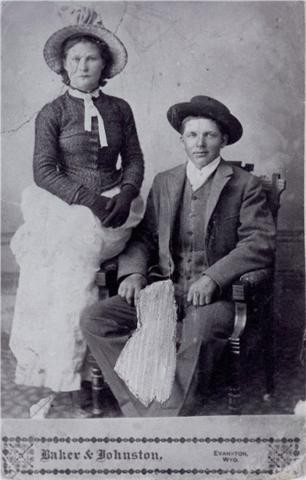
George Southam and his first wife, Jane
Jane was unable to have any more
children, so suggested that George take a plural wife. George
married Catherine Cameron 28 November 1862 in the Endowment House in Salt Lake
City, Utah. The family moved to Morgan,
Utah. While in Morgan four children were born to George and
Catherine: Mary Jane, George Henry, Eliza, and Alice. George
Henry remembered: "During my early childhood my father used
to go with his oxen up into Hardscrabble Canyon and bring
down railroad ties. He used to take me with him. The canyon
was steep and rough so I used to hang onto the tail of the
oxen going up the canyon."
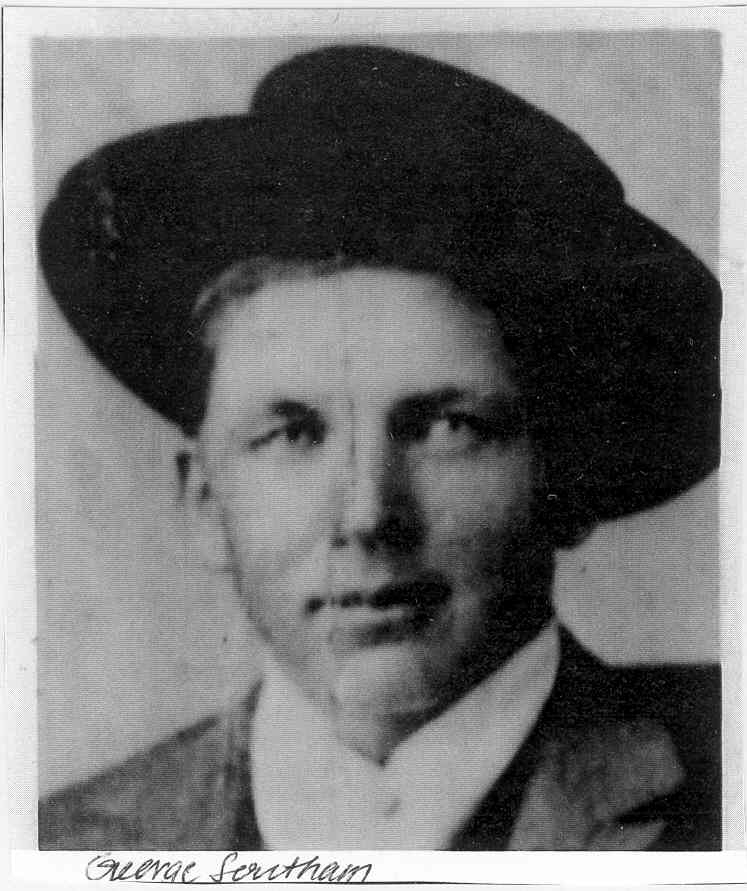
George helped other pioneers to come to Utah: “While still living in Morgan he was called to go back in 1868 as a teamster in an ox train that was going to Sweetwater to get immigrants, the last immigration before the railroad was completed to Ogden. The children got word that the last company of immigrants were coming and all gathered together to watch for them. The first thing the children saw was an American flag that George Southam had bought somewhere, it was hoisted above the wagon so it was the first thing they could see as they came in sight. He drove an ox team and was the oldest of the teamsters and was recognized as being reliable. He did not stay with the train until it reached Salt Lake but stopped off at his home and reported to Salt Lake City later.” (George Henry Southam)
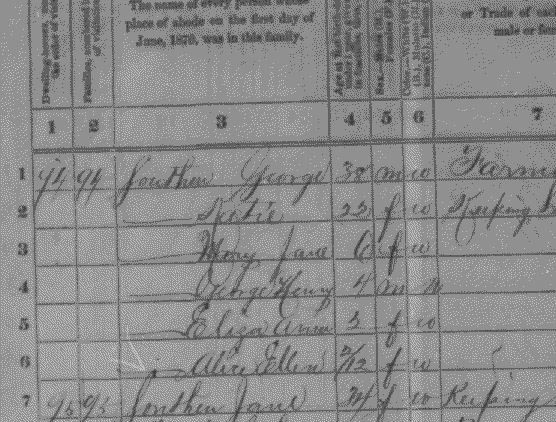
1870 census, Morgan, Utah
George moved both of his wives
and the four children to North Evanston,
Wyoming. Here he bought a home and they all lived together.
His descendants remember: “George Southam never paid rent
and always advised his children to own their home.” His
son, George Henry remembered, "Father bought a house in
what is now North Evanston and moved both of his wives and
children into it. He secured employment in the railroad
shops as engine tender. He bought stock, mostly milk cows,
with the thought in mind of securing a ranch as soon as
possible and the responsibility of taking care of them was
turned over to me as my father was working ten hours a day.
He worked for $1.76 per 10-hour day and jobs were scarce."
He worked for the Union Pacific railroad in Evanston for
several years. Jane Carter Southam separated from George while
they lived in Evanston: "Aunt Jane Carter Southam, Grandpa
Southam’s first wife, married Daniel Williams after she
separated from grandfather. She left him while they were
living in Evanston and came back to Morgan to live. She
later married Mr. Williams and raised his family of
motherless children." (Alice Southam Cook, in
the Life of George Henry Southam) In a biography of
George Henry Southam a descendant remembers:"In the spring
of 1877, there was an epidemic of black small pox and his
family was one of the first to get it. His brother James
died and was buried in a little knoll near the house. George
got very sick with it but survived."
George hoped to raise his
children in a Latter-day Saint community. His grandson, John
H. Haslem remembers: “In the fall of 1885, George Southam
asked his son, George Henry (Harry) to go out to Ashley
Valley to look for a new home, as he wished to raise his
family in a Mormon community, where his children might
select companions of Latter Day Saint members. Evanston had
many good people, but not many Latter Day Saints, and the
railroad brought many who were not so good.” Catherine’s
father, John Cameron, had settled in Randolph,
Utah. George bought property there, but was never able to move
his family there. "Father found that he could not support
his family with the work he could obtain at Randolph so he
sold his property there and moved to Wasatch, Utah. In those
days people lived in town because of the Indians. The church
authorities advised this because of greater protection;
also, in church the women usually sat on the left side of
the building and the men on the right so the men could get
out fast if necessary. We bought a house on railroad
property, also some corrals and other conveniences to take
care of our cows as we had brought part of them with us.
Here it was my responsibility to care for the stock. Father
worked on the railroad." (George Henry Southam)
George was a devoted father, and
a faithful Latter-day Saint. His son, George Henry, recalls an
incident of faith: “It was while we were working on a ditch
one day that a messenger came and told us we were to come to
a meeting. It was the custom at that time that if important
news or special instructions were about to be given, that
several boys were sent to the different homes to inform the
settlers of a meeting then we assembled at a public meeting
place and instructions were given. When we assembled this
time a Mr. West spoke to us and said that a call had come
for assistance in the building of the St. George Temple.
Different ones got up in the meeting and volunteered
different things toward it and my father George Southam
offered $15 in stock. I knew what my father owned and just
the load he was carrying and I thought to myself, "Old Boy,
where are you going to get it?" As we went back to work I
asked him where it was coming from. He looked down at me for
a moment and then said, "You wait and see." A short while
afterward my father and I were on our way to work on the
same ditch when a man called my father and said there is a
steer at the tithing yard that had been gathered in the
roundup and it belonged to father. It turned out to be one
that had not showed up in the roundup the year before and he
could get no trace of it and had considered it lost. After
talking to the man we walked on to work and my father looked
down at me again and said, "Harry, you remember the steer I
promised for the St. George Temple?" I replied, "Yes", and
he said, "That's it." That was a lesson in faith that I
never forgot.”
The Southam family appears in the 1880 Federal Census for Wyoming:
Name
Relation
Married Age Sex
Occupation Own/rent
home Birthplace
Father's Birthplace Mother's Birthplace
George W.
Southam Head
Mar
48 M
Farmer
owner/tenant
England
England
England
Katie
Southam
Wife
Mar
32 F Keeping
house
Scotland
Scotland
Scotland
Mary J.
Southam
Child
Unm
16 F At
home
Utah
England
Scotland
George H.
Southam
Child
Unm
14 M At
home
Utah
England
Scotland
Alice
Southam
Child
Unm
8 F At
home
Utah
England
Scotland
William
Southam
Child
Unm
3
M
Wyoming
England
Scotland
Emma
Southam
Child
Unm
1
F
Wyoming
England
Scotland
(1880 Federal Census,
Uinta, WY Enum. Dist. 2 Reel 1454 Page 334)
On Christmas Eve 1885 George went
to the ranch to take care of the cattle. In the evening he
prepared to return to town, as the family was going to a
Christmas party at the church. As he crossed the ice with his
team and wagon, the ice broke. George, with his team and
wagon, were dragged under the ice and drowned. Friends
searched for his body, but were unable to find it for several
days: “His body went under the ice, and wasn't found for
five days while his family suffered, and friends searched in
vain to locate his body. All had given up hope of finding
him, when the mother of George Southam appeared to his
daughter Alice (thirteen years old), in a dream. She told
Alice her name was Lucy Hunt, and she was George Southam's
mother, and she needed her son to help her. She also told
Alice where to cut the ice, some mile or so from where he
had drowned to find him. Alice said she had seen the willow
branch that he was lodged in, in her dream just as plain as
when they saw it, and found her father. Alice woke her
mother in the night after her dream, and said, "We will find
Papa tomorrow." James Williams said he would try just this
one more place, and then they would give up the search, as
it was so cold on Bear River, cutting ice. This time Alice
showed them the right place to cut, and they were
successful. About a week before George Southam was drowned,
he had a dream that he was going on a mission. He told his
wife that he was either going on a foreign mission or would
be called to the other side of the veil, and if he did die
to be sure he was buried in a Mormon Cemetery, and in his
temple clothes.” George was buried in Randolph, Rich, Utah.
The Deseret News for January 4,
1886 read:
“Mr. George Southam, who for
many years has been a resident of Uinta County, Wyoming, met
with a fatal accident near his residence on Bear River, last
Christmas day. He went to Evanston in the morning to
transact some business and visit his family. His wife wished
him to remain to eat dinner, but owing to having stock shut
up at home that needed feeding, he decided to return to the
ranch, eight miles distant, feed the animals liberally, and
then return to his wife and children, after which he
intended to attend the Christmas tree at the “Mormon”
meeting house and then go to the ranch next morning. As he
left, he told his wife that, if nothing happened, he would
be back by 2 o’clock in the afternoon. The stated time came,
the family waited for an hour or so, and then, coming to the
conclusion that matters of importance had detained him, they
gave up seeing him for the day. Evening came on and the
family were busily engaged in preparing to attend the
Christmas tree, when one of the daughters, a young woman,
sang out to her mother that she heard her father drive up to
the stable and shout “whoa!” to his team. Supper was made
ready, and as it was getting late, the family left for
church, leaving as they supposed, Mr. Southam to partake of
a warm meal and then follow them. In the midst of the
evening’s enjoyment they were surprised to hear that Mr.
Southam’s team had been seen struggling in the river during
the afternoon by passing railroad men. Parties immediately
started to the rescue, and it was found that the team had
broken through the ice over about eighteen inches of water,
and, being unable to extricate themselves, had perished.
Diligent search was made at the ranch and on the river bank,
but no trace of Mr. Southam was found. It was at this
juncture supposed he had gone under the ice, and a number of
citizens proceeded to cut the ice from a shallow riffle
below where it was known that the body could not pass, and
after three days’ hard work they found the corpse a short
distance below where he went under the ice. The remains were
taken to Evanston, an inquest held and verdict rendered in
accordance with the facts. It was found upon examination
that his neck was broken. There were also some slight
abrasions about the face. As to just how the fatal accident
occurred, is all conjecture, but it is supposed that the
front wheels broke through the ice with such suddenness as
to throw Southam form the wagon, striking upon his head with
such force as to break his neck, after which the horses, in
their floundering, probably forced him underthe ice. The
funeral services over the remains of the deceased, who was a
“Mormon,” was held in the meeting house at Evanston on
Wednesday evening last, and the body was sent to Randolph,
Utah, for interment in the cemetery, there where several of
his children are buried. Brother Southam was fifty-six years
of age, and leaves a wife and a large family of children to
mourn his loss. The bereaved family have the sympathy of a
large circle of friends.”
Another biography of George Southam:
FAMILY GROUP
RECORD OF
GEORGE SOUTHAM
AND CATHERINE CAMERON
GEORGE W. SOUTHAM was born 29 October 1830 in Neithrop, Banbury Parish, Oxfordshire,
England to Justinian
Southam and Lucy
Hunt. His mother died when he was only one year old. In
the census of 1841, the ten year-old George is found living in
Bourton with the Hunts, his
mother's family who were weavers. George worked as a plush weaver in Banbury.
He married Jane Carter 29 November 1854. They had one son,
Finas Henry, born 28 January 1856 in St. Louis, Missouri.
Finas Henry died 21 October 1856. George married Catherine
Cameron 28 November 1862 in Salt Lake City, Utah. Catherine
was born 21 April 1847 in Glasgow, Lanark, Scotland to John
Alexander Cameron and Margaret Fairgrieve. George died 24
December 1885 in Evanston,
Wyoming, and was buried in Randolph,
Rich, Utah. Catherine died 17 August 1929 in Vernal, Uintah, Utah. George and
Catherine had the following children:
1. Mary
Jane, born 17 April 1865 in Round Valley, Morgan, Utah;
marred Warren Leslie Allen; died 14 May 1913.
2. George Henry, born
5 May 1866 in Morgan, Morgan, Utah; married Elizabeth Jane
Hacking; died 30 January 1959.
3.Eliza
Ann, born 2 June 1868 in Evanston, Wyoming; died
28 December 1877.
*4. Alice Ellen, born
13 April 1870 in Morgan, Utah; married Joshua Haslam 27 July
1887; died 6 March 1952.
5. Ruth,
born 3 February 1873 in Evanston; died 24 February 1873.
6.James,
born 18 August 1875 in Evanston; died 22 June 1876.
7. William,
born 5 July 1877 in Evanston; married Mariah Pope 24 December
1901; died 21 July 1941 in a
family mystery.
8. Emma,
born 15 May 1879 in Evanston; married Charles Holmes 21 May
1898.
9. Margaret,
born 30 January 1882 in Morgan; married Don C. Pope 8 August
1900; died 8 Feb 1905.
10.John,
born 13 April 1885 in Evanston; died as a child.
SOURCES: IGI; Endowment House records.